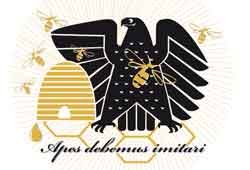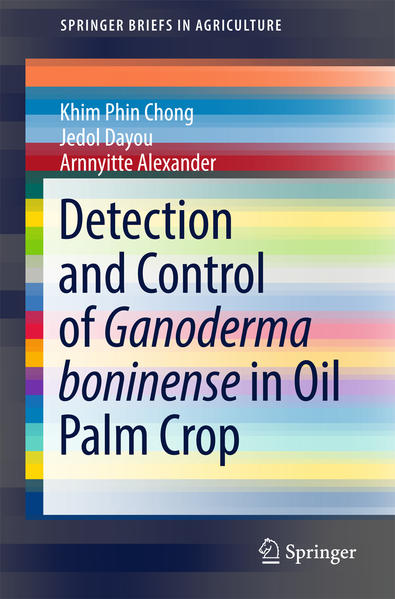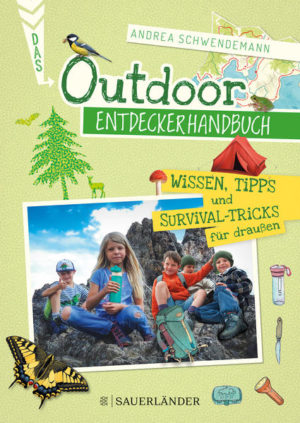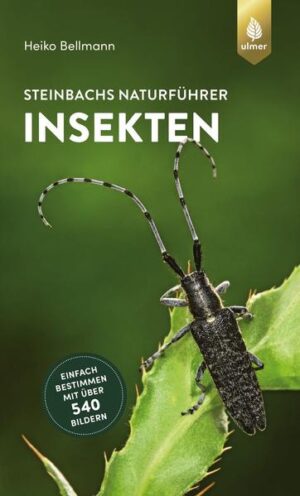- Softcover: 50 Seiten
- Verlag: Springer International Publishing
- Autor: Khim Phin Chong
- Auflage: 1. Aufl., erschienen am 21.04.2017
- ISBN-10: 3-319-54968-5
- ISBN-13: 978-3-319-54968-2
- Größe und/oder Gewicht: 23,5 x 15,5 cm
Detection and Control of Ganoderma boninense in Oil Palm Crop
Autoren: Khim Phin Chong58,84 €

HONIGHÄUSCHEN (BONN) – This Serves as an exclusive source of information BSR caused by G. boninense. It is a valuable and a must reference and guide for planters, agricultural students, agronomists and all those working in the oil palm industry. The authors believe this book will complementing the existing books on different approaches in the similar field as this book will discuss in-depth details and guidance on controlling the BSR disease using biological means, which is the unique features of the book itself. This book compiles precise and detail information on current detection methods. Infection of Ganoderma only appear at the very late stage of infection where more than 70% of the internal tissues have decayed, leaving no chance to cure the infected palms. Therefore, early detection of infected palms in advance of terminal symptoms is crucial. New approaches which has been proven possible to be conducted in field will be also provided. The key advantages of the reviewed detection methods are to help the readers to determine the best measure they could apply that suit their availability and accessibility. Oil palm is an international commodity used for food, household and industrial purposes. It is the world highest oil producer crop with potential yield capacity of 10 to 15 times higher compares to other oil crops planted on the same size of land. Increases in global demand for edible oil and biofuel, driven by the increasing population remains the main factor driving up the expansion of oil palm cultivation in South East Asia (SEA) countries and other region of the world. Currently, Malaysia and Indonesia are the two countries which contributed to 90% of the worlds palm oil export. Unfortunately, the oil palm industry in SEA is under threat of a devastating disease. This disease is known as Basal Stem Rot (BSR) which caused by a fungus, Ganoderma boninense. In Malaysia alone, the economic loss caused by this disease was estimated between RM 225 million to RM 1.5 billion (up to 500 million USD) a year. With no known remedy at present, BSR disease continues to erode the profitability of the oil palm industry, and created a significant concern globally. This book is a joint effort by the authors whom are currently working actively on finding control methods of BSR disease in oil palm. With immense experience in the field, this book provides information with data backup covering both detection and control strategies of Ganoderma. Many researchers have agreed that most of the failures to control this pathogen are due to the lack of knowledge about this pathogen. Hence, this book provides information on the pathogenic nature of G. boninense. Prior understanding of the pathogen biology and their mode of infection provides the audience a new insight into BSR epidemiology that enables the implementation of appropriate management strategies. This book presents a detailed review on the control measures on BSR disease that is currently taken. These include cultural control that is practised most of the time, chemical control using formulated fungicidal and development of disease resistance variety. Focusing on a specific issue which need urgent attention with good supporting data, this book gives a more in depth information on the use of biological approaches in controlling G. boninense to meet the current oil palm-environmental dilemmas and demand of more eco-friendly practices in the field. Biological agents have been proven to be successful in many different models. In this book, the proposed methods address combinations of biological control agents (BCA) to improve the limitations of single BCA application. The results presented are based on trials conducted all the ways from in vitro to nursery and finally in the field (under the most commonly practiced agronomic practices). The 6 chapters in this book address many current issues in tackling the pathogen and development of sustainable disease managment programmes. There are, an introduction to the oil palm industry in global prespective and its future potential (Chapter 1), The pathogenic nature of Ganoderma (Chapter 2), Current detection methods of G. boninense which are sub-divided into Lab-based and Field detection methods (Chapter 3), Control methods of the pathogen, which covers cultural practices, chemical control, development of disease resistance and biological control (Chapter 4), Integrated control of G. boninense using combination of biocontrol agents (Chapter 5) and finally an overview of the book content which summarize the discussed matters as well as suggest several recommendations for future research or improvement attempts (Chapter 6).
Über „Detection and Control of Ganoderma boninense in Oil Palm Crop“
Das vorliegende Sachbuch zu Themen aus Umwelt und Natur „Detection and Control of Ganoderma boninense in Oil Palm Crop“ wurde erarbeitet und verfasst von Khim Phin Chong. Dieses Sachbuch erschien am 21.04.2017 und wurde herausgegeben von Springer International Publishing.
Bücher wie „Detection and Control of Ganoderma boninense in Oil Palm Crop“ sind im Onlineshop des Honighäuschens bestellbar. Online bestellte Fachbücher zur Imkerei und zu anderen Themen der Umwelt und des Artenschutzes sind zu den üblichen Öffnungszeiten auch direkt im Buchladen Bundesamt für magische Wesen in Bonn, der Stauhauptstadt von Nordrhein-Westfalen abholbar und werden auf Wunsch verschickt.
Das Thema Bienensterben, Rückgang von Insekten und allgemeines Artensterben ist in aller Munde und das Honighäuschen als frühere Bioland Imkerei hat sich von Anfang an daran beteiligt. Mehr als 35 Jahre Imkereierfahrung nahmen ihren Anfang 1982 mit den ersten eigenen Bienen.

Der zehnjährige Junge, der 1977 einem Hamburger Imker über die Schulter schaute; der Fünfzehnjährige, der mit der Imkerei in Zeiten begann, in denen es noch keine Varroamilbe gab; der achtzehnjährige Fahrschüler, der lernte, dass man die Windschutzsscheibe seines Autos nach einer längeren Fahrt von Insekten säubern muß; der zwanzigjährige Student, der für seine Bienen einen Platz in Bonn suchte; der dreißigjährige Berufsimker, der seinen Bienen quasi eine Gutenachtgeschichte erzählte und sich den Kopf zerbrach, wie man die Umwelt mit ihren Bienen, Wespen, Schmetterlingen und andere blütenbesuchenden Insekten vor den Machenschaften der Agrargiftindustrie und der Gleichgültigkeit agrarindustriehöriger Politiker schützt; der Imker, der nicht nur auf dem Weihnachtsmarkt Bonn die Öffentlichkeit suchte, um bei Führungen an den Bienen auf dem Dach der Bundeskunsthalle zu erleben, dass Kinder (und deren Helikoptermuttis!) Angst vor Schmetterlingen hatten, bis hin zum Begleiter von Forschungsprojekten zu den Riesenhonigbienen Nepals oder den Killerbienen Afrikas, stellt fest, dass etwas sehr im Argen liegt in unserem Umgang mit der Umwelt.
Es sollte jedem bewußt sein, dass die Haltung „Natur ja, aber bitte woanders!“ nicht in Ordnung ist.
Die wunderschöne Welt der Natur

In unserem Online-Buchshop finden Sie viele Bücher wie „Detection and Control of Ganoderma boninense in Oil Palm Crop“, die Ihnen die fantastische Welt der Bienen, Wespen, Ameisen, Hornissen und Schmetterlinge sowie anderer Insekten näherbringen.
Aber nach wie vor stehe ich Ihnen auch gern zu einem Gespräch oder zu einer Beratung im Umgang mit Bienen, Wespen, Hornisse, Wildbienen und Hummeln zur Verfügung, wenn Sie Fragen haben. Besuchen Sie uns in Bonn im Bundesamt für magische Wesen.
Und natürlich gibt es auch weiterhin Honig, Bienenwachskerzen und Met bei uns und zwar das ganze Jahr – nicht nur zu Weihnachten.
| Gewicht | 1175 g |
|---|---|
| Größe | 23,5 × 15,5 cm |
Marke
Springer International Publishing
Nur angemeldete Kunden, die dieses Produkt gekauft haben, dürfen eine Bewertung abgeben.





Bewertungen
There are no reviews yet